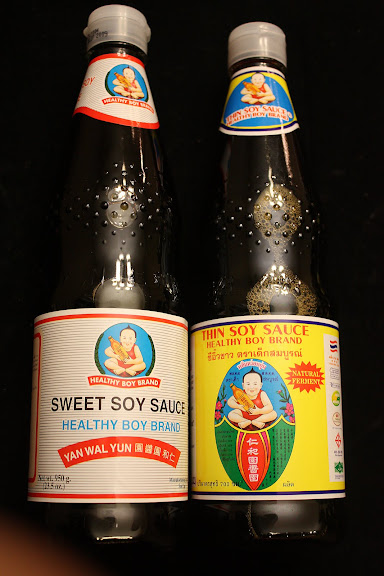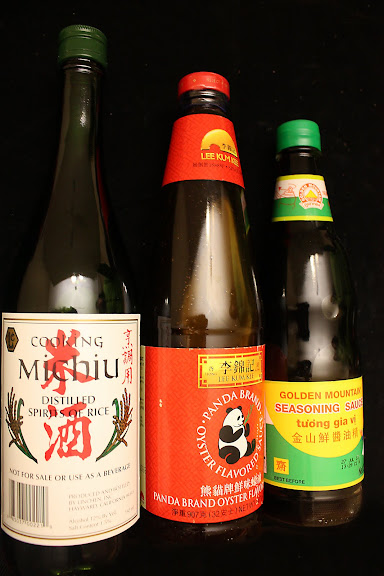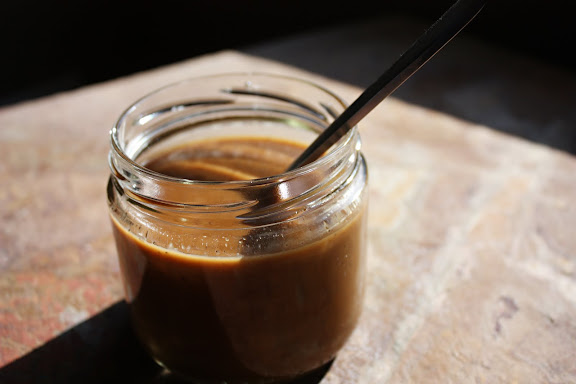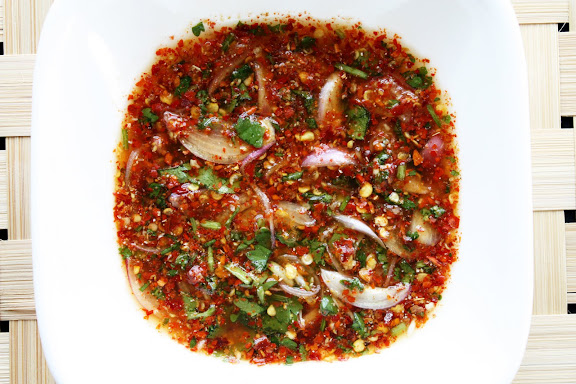 Our subject today is the major soy sauces (ซีอิ๊ว) used in Thai cooking. This is by no means an exhaustive list. Only what I consider to be the major players are included.
Our subject today is the major soy sauces (ซีอิ๊ว) used in Thai cooking. This is by no means an exhaustive list. Only what I consider to be the major players are included.
Let’s start with the ubiquitous table sauce, Maggi, a sauce generally described as being made from vegetable protein to resemble soy sauce without actually containing soy. [Maggi is by no means the only brand used in Thailand, but it has become a generic name for all brands of table soy sauces, much like Kleenex. It’s not uncommon for some people to point to a bottle of obviously non-Maggi brand of table sauce and say, “Could you pass me some Maggi?”]
However, due to the way in which it is used among the Thais, I think it’s appropriate to put this very concentrated sauce in the soy sauce category.

This is the table sauce of choice for most Southeast Asian kids and adults alike. In general, Maggi is not used as a cooking sauce; its job is to accent or embellish a finished dish rather than act as a cooking ingredient. In other words, Maggi functions in a similar manner to Tabasco sauce, A-1 sauce, or—in some way—table salt and pepper. A few drops of Maggi over a bowl of pork congee, or rice and hard-boiled eggs or Thai-style omelet (ไข่เจียว) made my childhood a truly happy one.
Another major soy sauce is sweet dark soy sauce (ซีอิ๊วหวาน). This is very similar to the sweet soy sauce in the Indonesian kecap family — the essential ingredient in the much-loved Pad See Ew (phat si-io, ผัดซีอิ๊ว), fried flat rice noodles with sweet dark soy sauce. It is also heavily used in Chinese-influenced red-cooked or braised dishes that are found in the Thai repertoire. Nothing can replace or mimic its salty-yet-sweet, caramel-y-yet-smoky flavor. It’s one of my favorite soy sauces in the whole world.
Notably, sweet dark soy sauce is also often served as a table sauce alongside the spicy ginger-chilli-garlic-soy sauce which accompanies Khao Man Gai (khao man kai, ข้าวมันไก่) for those who prefer a less spicy sauce. Both sauces are almost always offered at a Khao Man Gai joint for this reason.

When I was a little kid, Dad and I would go on dates once or twice a month. One of our favorite date spots was a neighborhood Khao Man Gai eatery that served what I remember to be the most delicious version of this chicken and rice dish I’ve ever had. (Or it simply could be that anything eaten in Dad’s loving presence tasted good.) Knowing I was too young to handle the spicy Khao Man Gai sauce, Dad would drizzle some sweet dark soy sauce over my rice. And oh, how I adored it.
The taste of sweet dark soy sauce is seared into my memory and will always be mentally associated with how wonderful life was when Dad was alive and how blessed I am to have a truly magnificent man as my father.
[You fathers out there, please go on dates with your daughters. I’m willing to bet that years from now they will write blogs or books about how everything eaten in your presence tastes wonderful. Yes, even soy sauce.]
Another major player on the soy sauce scene is light or thin soy sauce (ซีอิ๊วขาว). “Light” in this context doesn’t not refer to its lower sodium content (as in 50% less sodium “light” Kikkoman that comes with a green cap); it refers to its lighter, thinner consistency and gentler, less in-your-face taste.
Its Thai moniker, ซีอิ๊วขาว, can be misleading as it literally means, ‘white soy sauce.’ Well, there’s nothing white about it. I guess it’s a convenient way of differentiating this thinner, lighter soy sauce from its more concentrated, thicker, darker counterparts.
This type of soy sauce is less salty than the dark soy sauce and—unless my taste buds play tricks on me—sweeter. The consistency and taste of “white” soy sauce are very close to those of fish sauce, although the two are never interchangeable, in my opinion. Some have asked me whether it’s a good idea to use “white soy sauce” instead of fish sauce to make vegan or vegetarian Thai curries, and my answer is, no, use salt. But this is just a personal opinion and by no means a dogma. I happen to think traditional Thai curries that are seasoned with soy sauce (of any kind) are disgusting.

We’re moving on to the penultimate item: dark soy sauce (ซีอิ๊วดำ—literally “black soy sauce”). Golden Mountain and Healthy Boy are what I use in my cooking and recipe testing. (They’re also two most prominent brands among the imported Thai soy sauces in the US, from what I’ve seen.) At a risk of stating the obvious, dark soy sauce is darker than light soy sauce. (Isn’t this enlightening?)
One last note on soy sauces used in modern Thai cooking: I don’t ever use Japanese-style or Korean-style soy sauces or soy sauces brewed according to the Japanese tradition (Kikkoman) in Thai cooking unless in extreme cases. The flavors of such sauces lend themselves to the East Asian cuisines for which they are designed, and I find them to be out of place in Thai cooking. The same holds true in reverse. Serve Golden Mountain or Healthy Boy soy sauces with sushi to those who know better and watch sake flasks fly in your general direction.
Lastly, oyster sauce (น้ำมันหอย or ซ้อสหอยนางรม – literally “oyster oil” and “oyster sauce” respectively). Again, this is not exactly soy sauce, but I have placed it in this category due to the manner in which it’s used in Thai cooking. I think of it as umami-filled soy sauce with built-in starch. For vegetarians, look for Chinese brands of “oyster” sauce that is made from mushrooms.
Some facts about oyster sauce:
- While the other types of sauce listed here function either as a table sauce (Maggi) or both a table sauce and a cooking sauce (light, dark, and sweet dark soy sauces), oyster sauce is almost exclusively a cooking sauce. At least, I’ve never seen it used as a table sauce in my lifetime.
- Oyster sauce is a complex sauce containing what I suspect to be high amounts of Monosodium glutamate (MSG). That’s why a little bit of it goes a long way in providing flavor as a stir-fry sauce or marinade. If you’re ultra-sensitive to MSG, ask your favorite Asian, especially Chinese, restaurants that put up the “No MSG” sign whether they use oyster sauce in their cooking. If so, and I think that’s mostly the case, their foods contain MSG by way of the oyster sauce even though they do not lie about using the crystalline MSG.
- A recent Oyster Food and Culture article on the making of soy sauce around the world reminded me of someone I’d thought about introducing to you since last summer. I had drafted a post on him and kept it in my draft folder for a long time. You see a part of me wanted people to know of him; another part of me wanted to keep him a secret.The urge to share won out. Everybody, meet Bruno.

My dark tan (hence the name) love, Bruno, is the strong, quiet type, but gets along with others really well. He is low-maintenance and can take care of himself just fine. Though Bruno is the type that spends most of his time in a cold, dark corner minding his own business, the moment I reach for him, he can leap to work at a drop of a hat. All I need to do to get him ready is shake him up violently. Bruno’s performance is solid, stellar, consistent, and always satisfying.You know how bread geeks avid bread bakers name their sourdough starter? Bruno is the name which I have given to my all-purpose, go-to brown stir-fry sauce. I am never without Bruno.
Containing soy sauce, oyster sauce, sesame oil, and Chinese wine, it doesn’t take an expert to figure out that Bruno is not a traditional Thai stir-fry sauce. What would an ‘authentic’ Thai stir-fry sauce be? There’s no such thing. Thai-style stir-fries are very simple. Most often, they start with the browning of chopped garlic in lard or vegetable oil, followed by the sauteing of your meat of choice (sliced thinly and small enough to fit on a spoon), and vegetable(s). Decades ago, the seasoning ingredient would be a few splashes of fish sauce and a pinch of ground white pepper. These days, light soy sauce and oyster sauce are almost always added along with the fish sauce.Bruno takes you in a different direction, setting you on the path of the stir-fries you’d most likely find at most Thai restaurants in the US which are heavily influenced by the stir-fries you’d most likely find at Chinese restaurants in the US. Having a premade sauce like Bruno is often the way they cook at most Thai restaurants stateside. You know what it’s like. You and five co-workers visit a Thai restaurant during the busy lunch hour. You all flip through the menu and order six different lunch specials. Less than 10 minutes later, your server places six plates of steamed Jasmine rice topped with six different stir-fry and dry-curry varieties—all complex-looking stuff that you don’t even dare attempt to replicate at home. You look around and notice that other diners also receive their orders around the same time. You start thinking that they either have a legion of cooks in the kitchen or the one they have has 5 extra sets of hands.
In a perfect world, upon receiving your lunch order, someone in the kitchen would measure out 10 different fresh herbs and spices, grind them up into a paste with a pestle and mortar, and create one perfect single serving of Thai stir-fry for you. In the real world, it’s all about pre-fab cooking. This is fact. And I don’t see anything wrong with that. Without going all Sandra Lee on you, most, if not all, Thai restaurants have (and guard with their lives) their own Bruno formulae for various types of Chinese-influenced stir-fried dishes.
My Bruno consists of 1 part Thai light soy sauce, 2 parts oyster sauce, 1 part Thai dark (not sweet) soy sauce, 1 part Chinese wine or sherry, 1 part cornstarch, 1/2 part sesame oil, and 1/4 part ground white pepper. I usually make about a quart of Bruno at a time and keep him in a huge glass jar in the refrigerator. You need to put Bruno in a jar with enough head space, because the cornstarch sinks to the bottom of the jar and you need to give Bruno a good shake in order to get him ready to work.
How to use Bruno? I use 1/2 cup of Bruno, plus 3/4 cup of water, for every 2 pounds combined weight of stir-fry ingredients. This is my favorite ratio; your mileage may vary.

What’s good about Bruno is that apart from the added sesame oil I don’t put additional oil into my stir-fries at all; there’s just no need for it. When I stir-fry with Bruno, I go against the usual stir-fry protocol. I heat up the pan over medium heat, add to the pan the ingredients in the order of lengths of time required starting from the longest first, add Bruno to the mix followed by the water, and close the lid. When all the ingredients have been cooked through and the sauce has thickened, remove the pan from heat. That’s all there is to it.Have fun with Bruno. Use him with different vegetables, meats, add-ins (fresh chillies, sliced ginger, herbs, etc.). I bet you’ll love him as much as I have loved him and only him these past several years.












